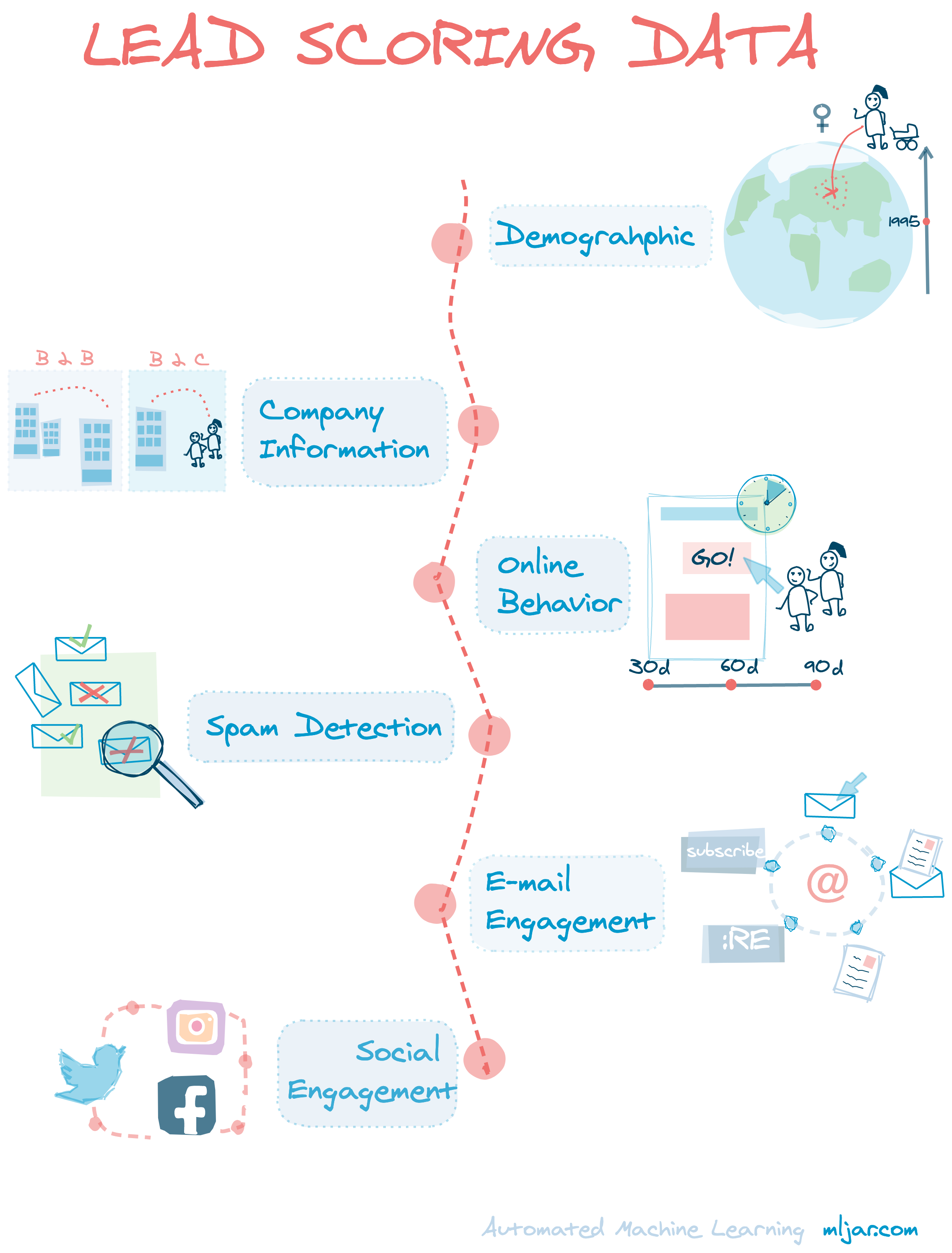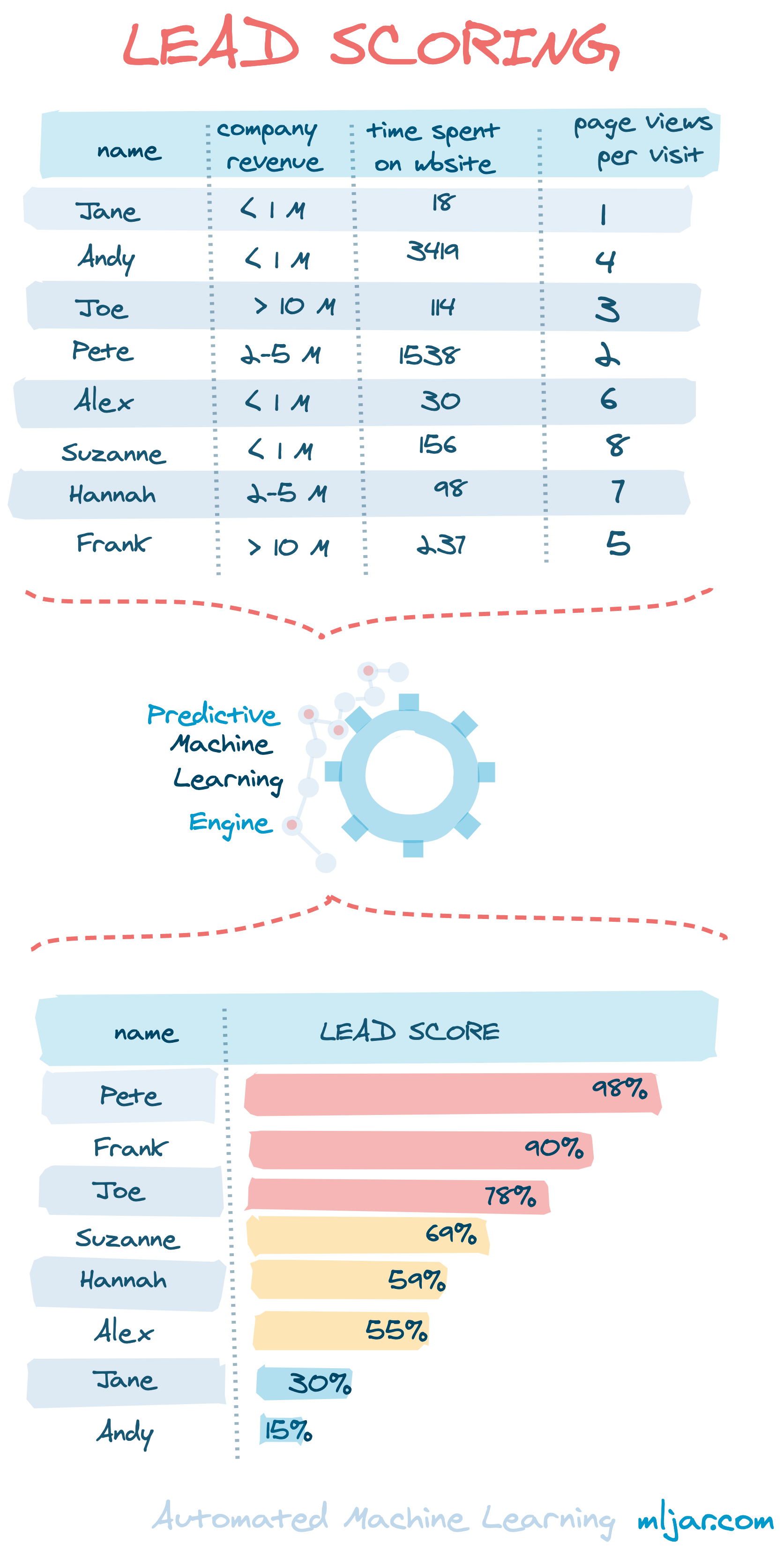Machine Learning for Lead Scoring
If you're selling, promoting, and engaging customers to buy new services, you've certainly come across the concept of lead scoring. This term is a source of interest for marketing agencies that, engaging possible information about the client, look for those who will be interested in a specific product or service.
What is lead scoring?
Lead scoring is a method that allows you to distinguish people most interested in buying from the crowd of customers. It consists of collecting information about customers and assigning them points based on their characteristics, activity, behavior, and reaction to proposed offers. The customers with the highest number of points are so-called lead scores giving the greatest guarantee of finalizing the transaction. They are the focus of marketers' efforts, and from a certain point threshold also of sellers, to lead to the sale of a product or service.
Having data about the customer and drawing conclusions from historical data can determine the lead score - reliable information that tells how much the user is interested in the purchase. In the lead score method, it is crucial to define a scoring scale for individual behaviors and collect detailed data, both those provided by the customer and those gathered, such as cookies, based on customer behavior, choices, order history, e-mail engagement, etc. Lead scoring distinguishes between undecided consumers and those ready to buy. And thanks to personalized communication, potential customers are not overwhelmed by marketing activities. Contrary, they feel that you know their needs and that you are able to meet them.
Types of leads
Two types of leads can be distinguished: marketing and sales leads. Lead marketing is a person interested in a specific product. He's willing to find out more about the offer's details, what is proved by, e.g., signing up to the subscriber base, taking part in a webinar, or downloading information materials.
The next stage of involvement is the sales lead. It is a person who has expressed interest in the offer, e.g., by sending an inquiry or creating a trial account. The transfer of a lead from the marketing department to the sales department is a delicate process that can affect the transaction's finalization.
Types of data in lead scoring
The collected data about customers can be divided into several types.
- Demographic information. Demographic data includes, e.g., location (country, city of residence, or seat), gender, age, occupation, and family status.
- Company information. This category contains information regarding the customer's status; whether it is an entrepreneur or a consumer, it determines the B2B or B2C relationship's nature. It includes the type of activity conducted by the company, scope, size of the company, number of employees, and revenues.
- Online behavior. It is information about the customer's behavior on the website, i.e., which landing pages he visited, how much time he spent on each page. Was he downloading free material, clicking links, searching for something on the site, or subscribing?
- E-mail engagement. Data on potential customers' engagement based on the messages you sent that most interested the customer, regardless of whether they were promotional offers or reminders about expiring bonuses. Or maybe you send your client's interesting facts about your industry, hot topics? It is crucial information whether the person opened your e-mails and clicked on the given links, thus showing their commitment.
- Social Engagement. A valuable collection is a data on the involvement of potential customers in your social networks. Sharing, liking, or commenting on posts on different channels is proof of engagement. You can assign different values to leads depending on their activity, high Klout score, or the number of followers.
- Spam detection. It is the so-called negative scoring when you assign negative points to potential customers in a specific way based on completed forms. If you offer services to companies, e-mails in popular domains (e.g., Google) will be treated as spam. If the form were filled in by entering illogical expressions, random characters - it would also get a negative assessment.
Note that the greater scope of collected data and the preserved historical data, the greater the set's value, which can be the basis for forecasting using automatic machine learning.

Difference between traditional and predictive lead scoring
In traditional lead scoring, each user is manually assigned the appropriate number of points for a specific activity. It requires a lot of employee involvement in this process. Exceeding a certain point threshold increases the probability that the indicated lead will be interested in purchasing a service/product. The lead scoring method starts with the same in both cases (traditional and automatic). First, you need to get to know and collect data about leads. The first step is to configure the customer's assessment by selecting the appropriate parameters and assigning weights to specific behaviors. Then, after verifying the actual lead conversion, you can update the assigned weights for individual activities. The marketer decides about assigning weights in the traditional method based on the information at hand. In automatic lead scoring, values are set automatically.
Automated lead scoring offers much greater possibilities to predict the interest of a potential client. If you provide a good dataset (more than 50 samples, large historical dataset, detailed data), you can get a better result in the form of a good model to help you pinpoint the most likely leads. What's next? Upload the dataset to MLJAR, select the appropriate parameters, algorithm, learning time, and see how artificial intelligence does it. It remains to supervise the model and follow its results. Remember, the more data, the more reliable the model will be. The more time you train a model, the more accurate the results will be.
What is an essential element of automatic lead scoring? It allows you to predict behavior based on historical data and create subsequent steps to increase customer conversion, which in traditional lead scoring would require time-consuming and complex analysis. Your analyzes can reveal a lot of information about your customers and their behavior. You can determine which campaign has attracted the most leads or which actions have led to the most conversions and adjust your lead scoring system accordingly. The advantages of automatic lead scoring are:
- predicting future leads
- precision of results
- elimination of human error
- time-saving - quick results

Conclusion
Thanks to lead scoring, you can send a personalized offer to a specific group of recipients, such as regular customers, new users, leads ready to buy, or undecided customers comparing many offers. And conducting advertising campaigns to a targeted audience will undoubtedly allow you to avoid high costs and dissatisfaction of customers who, being cornered by advertisements, may reject subsequent offers. Automated lead scoring with machine learning will enable you to concentrate your efforts on your exact marketing issues and save time.
About the Author
Related Articles
- PostgreSQL and Machine Learning
- Tensorflow vs Scikit-learn
- Extract Rules from Decision Tree in 3 Ways with Scikit-Learn and Python
- AutoML in the Notebook
- How does AutoML work?
- MLJAR AutoML adds integration with Optuna
- How to save and load Xgboost in Python?
- How to use early stopping in Xgboost training?
- CatBoost with custom evaluation metric
- The next-generation of AutoML frameworks
